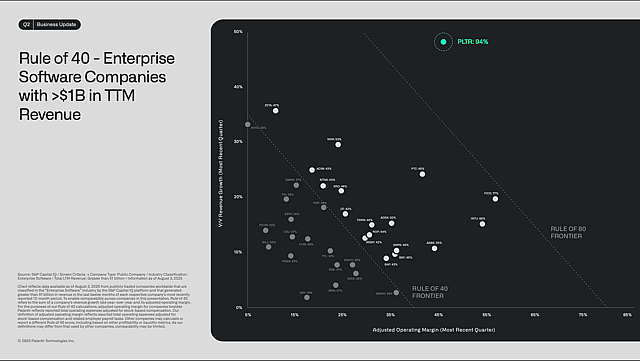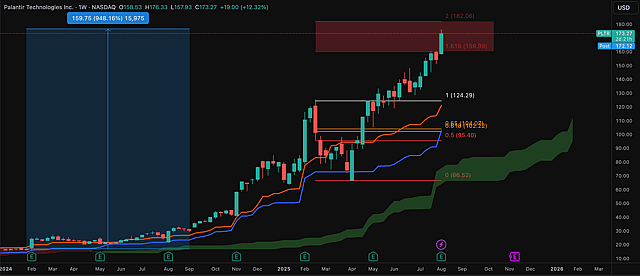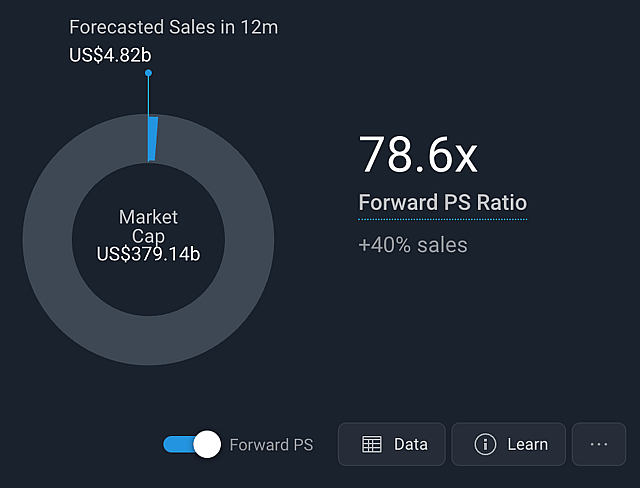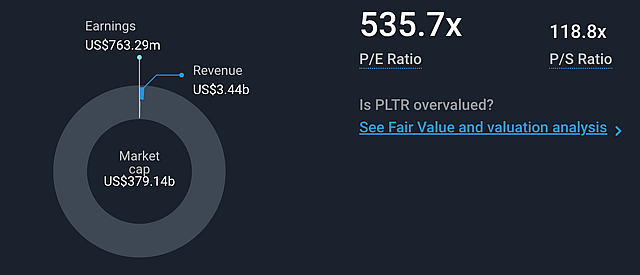Last Update 03 Nov 25
Fair value Increased 38%Palantir Did It Again!
Palantir came into Q2 priced for perfection... and delivered.
Revenue grew +46% year over year, blowing past already high expectations and pushing the Rule of 40 to a staggering 94. That’s elite, full stop. Even under standard accounting (including stock-based compensation), it still lands at a robust ~75, comfortably outperforming big tech players like Microsoft and Meta. This level of operational efficiency is almost unheard of for a company of this scale, and reinforces Palantir’s unique position in the AI and defense ecosystem.

Commercial traction remains robust, with U.S. commercial revenue up +69% YoY and international commercial up +28%. Momentum in AIP (Artificial Intelligence Platform) deployments continues to grow, with over 660 bootcamps held in Q2 alone, a testament to Palantir’s strategy of deeply embedding its tech into customer workflows.
On the government side, revenue grew +33% YoY, driven by strong U.S. demand. Notably, management guided for continued acceleration in government contracts in the second half of the year, as major awards from Q1 begin ramping.
Palantir also expanded its GAAP profitability, delivering $727M in TTM adjusted operating income with 44% margins. Free cash flow continues to climb as well, reaching $226M in Q2, up +42% YoY.
See Palantir’s full Q2 2025 business update: https://investors.palantir.com/files/Palantir%20Q2%202025%20Business%20Update.pdf
Still a premium business, with a premium price
The market responded quickly pushing the stock above $175. That puts Palantir up 10x from the 2024 lows, and cements its status as one of the most powerful AI narratives in public markets.

But at these levels, the stock trades at over 78x forward P/S. Even after another blockbuster quarter, it’s hard to argue the stock isn’t still priced for perfection.


Holding my ground (...and trimming a little)
My long-term view hasn’t changed: Palantir is still a company I want to own. Its position at the intersection of government, national security, and next-gen commercial infrastructure is unmatched. Execution remains strong. Momentum is real.
But valuation still matters. At $170+ and trading at over 500x earnings, the risk/reward just isn’t there for new buyers.
To be clear, I don’t think Palantir will ever be “cheap.” It will likely always carry a premium, and rightly so. But in my view, a 30%+ pullback from all-time highs would present a real opportunity, even if the stock remains above what I’d consider an already optimistic fair value.
If that reset comes during a broader market correction, I’ll consider adding. Until then, I’m holding my core position, trimming a bit to reallocate gains into ideas with more upside, and keeping a close watch.
Palantir did everything it needed to. That doesn’t guarantee near term upside, but the long term story certainly remains fully intact.
Company Overview

Founded in 2003 by Peter Thiel, Alex Karp, Stephen Cohen, Joe Lonsdale, and Nathan Gettings, Palantir Technologies emerged from the shared vision of transforming how data could be used to solve complex problems.
Peter Thiel, a co-founder of PayPal and a prominent venture capitalist, brought his knack for identifying transformative opportunities. He envisioned applying PayPal’s fraud detection methods—built on data analysis and pattern recognition—to broader, more complex domains, such as national security and business intelligence. Thiel's financial backing provided the foundation for Palantir’s creation.
Alex Karp, a former academic with a doctorate in social theory from Goethe University, was introduced to Thiel during their time at Stanford Law School. Karp’s unconventional thinking and philosophical perspective on technology’s role in society made him a natural fit to lead Palantir. As CEO, Karp shaped the company’s mission of enhancing decision-making through clarity in complex data.
Stephen Cohen and Joe Lonsdale, both talented technologists, joined the team with expertise in building cutting-edge software systems. Cohen, a Stanford computer science graduate, had previously worked with Thiel at Clarium Capital. Lonsdale, also a Stanford alumnus, was instrumental in refining the company’s focus on solving real-world problems through data.
Nathan Gettings, an early engineer at PayPal, completed the core founding team. His technical expertise in cryptography and secure systems aligned perfectly with Palantir’s ambition to create software capable of securely managing sensitive information.
The idea for Palantir was born out of the founders’ shared belief in leveraging data to uncover actionable insights while preserving individual privacy—a principle that shaped the company’s core technologies. Drawing its name from the “Palantír,” the seeing-stones in J.R.R. Tolkien’s The Lord of the Rings, the company embraced the metaphor of bringing visibility and clarity to vast, complex systems. This combination of Thiel’s vision, Karp’s philosophical approach, and the technical brilliance of Cohen, Lonsdale, and Gettings set Palantir on its path to becoming a leader in AI and data analytics.

Backed by the CIA’s venture arm, In-Q-Tel, Palantir became a key partner for intelligence agencies, providing tools to analyse and derive insights from vast amounts of data. Although many details remain classified, the company has been involved in high-profile operations, including the capture of Osama bin Laden and more recently, assisting Ukraine’s defense forces with AI-powered tools in the conflict with Russia.

The combination of Karp’s outspoken leadership, his pro-West rhetoric, and Thiel’s innovation-driven vision has fostered a cult following around the company. Retail investors and fans alike view Palantir not just as a transformative force in AI and data analytics, but also as a company with a clear mission. This fervor is amplified by the mystique surrounding Palantir’s operations, Karp’s charismatic persona, and the company’s strong ideological stance, making it a unique entity in the technology and investment landscapes (Forbes).

Palantir’s suite of platforms: AIP, Gotham, Foundry and Apollo, power advanced decision-making and operational efficiency across government and commercial applications.
- Gotham: Initially developed for government use, Gotham is Palantir’s flagship platform for intelligence analysis. It enables agencies to integrate, analyze, and visualize massive datasets, supporting critical missions such as counterterrorism, defense, and law enforcement. Gotham has been pivotal in high-profile operations, including military strategy and national security efforts.
- Foundry: Palantir's data operations platform empowers commercial organizations to unify disparate data sources into a single AI-ready environment. Foundry accelerates value creation by enabling businesses to operationalize data and deploy advanced analytics in weeks rather than years.
- AIP (Artificial Intelligence Platform): AIP integrates generative AI into enterprise workflows, enabling real-time, AI-driven decision-making. Its foundation, the Palantir Ontology, mirrors enterprise decision processes by combining data, business logic, and actions into a unified framework.
- Apollo: Palantir's mission control for software deployment, Apollo ensures secure, autonomous software updates across diverse environments. It underpins the seamless integration of AI-driven applications and facilitates reliable, scalable operations.
Together, these platforms form Palantir’s AI Mesh, which integrates foundational software, prebuilt AI solutions, and custom applications. This architecture provides organizations with the tools to harness AI effectively, whether for structured analytics, unstructured data exploration, or real-time operational applications.

As Karp has stated, “Once companies try Palantir, their competitors are forced to adopt it just to keep pace,” highlighting the competitive edge Palantir’s technology offers. This sentiment is reflected in Palantir’s performance.
For years, Palantir was often dismissed by skeptics and even labeled as a company with overly ambitious marketing or questionable ties to government surveillance. Critics have called it overhyped or overly secretive, and rumors have swirled about its dependence on government contracts and limited scalability in the private sector. However, the company’s recent financial performance and growing traction in commercial markets have gone a long way toward disproving these narratives, forcing even the harshest bears to reconsider Palantir’s potential as a leader in AI-driven transformation.
Financials
- Palantir’s financial performance underscores its impressive growth trajectory and operational efficiency. Over the past year, earnings surged by 223%, with a compound annual growth rate (CAGR) of 52.4% over the last five years, highlighting the company’s ability to scale rapidly and capitalise on increasing market demand.

- Revenues also reflect this strong momentum, growing 22.5% annually over the past five years, demonstrating a sustained acceleration in both the commercial and government sectors.

- Palantir has also made significant strides in improving profitability, with margins rising from 6.9% to 18% in the last 12 months. This improvement points to the company’s ability to leverage its technology more effectively, driving higher returns as operations scale. As Palantir continues to capture increasing commercial market share and optimize its processes, these margins are poised to expand further, solidifying its position as a highly profitable leader in the tech industry.

- The company closed 104 deals over $1 million and expanded its customer base by 39% YoY to 629 clients, with U.S. commercial customers growing 124.5% YoY.
- Palantir’s free cash flow margin stood at an impressive 60%, with $1 billion in adjusted free cash flow on a trailing twelve-month basis.
These results underscore Palantir’s ability to scale profitably, demonstrating robust unit economics with 80%+ gross margins and a 160% increase in net profit margins over the last 12 months. If this growth continues, Palantir has the potential to evolve into a high-margin business with a cash flow profile that could rival some of the top players in the industry.
Growth Catalysts
- The global shift toward AI-driven transformation is a significant growth catalyst for Palantir, with its Artificial Intelligence Platform (AIP) enabling seamless integration of AI into enterprise operations. This catalyst is supported by:
- Massive Market Demand: The rapid adoption of AI across industries is driving unprecedented demand for platforms like AIP, which enable organizations to stay competitive and operationally agile.
- Proven Impact: AIP consistently delivers measurable value, such as $10 million in savings for a manufacturing client and a 28% reduction in NHS hospital care backlogs.
- Scalability and Distribution: With over 500 AIP bootcamps conducted in 2024, Palantir is rapidly scaling adoption by empowering users to achieve outcomes quickly and efficiently.
- Market Leadership: Trusted by several U.S. government agencies with the highest security clearance and renowned for its unmatched data security capabilities, Palantir is now expanding its commercial footprint with clients like Ferrari, showcasing its versatility across sectors.

- Commercial and Government Synergy Palantir is platformizing its government offerings to allow defense contractors to build on its infrastructure. This shift smooths revenue cycles and opens new licensing opportunities. Combined with the explosive growth in commercial clients, Palantir is expanding its addressable market across both sectors.
- Financial Leverage Through Margins Palantir’s incremental operating margins of ~70% signal the potential for a 60-70% margin business as it scales. The Rule of 40 current score of 68% (81% as of Feb 2025) underscores its strong balance of growth and profitability, setting the stage for long-term financial outperformance.

- Palantir also made the strategic move from the New York Stock Exchange to Nasdaq on November 26, 2024, gaining inclusion in the Nasdaq-100 Index on December 23rd. The stock was also included in the S&P500 in late September 2023. This shift could potentially attract significant capital from passive investments in index funds and ETFs, further boosting the company’s price.
Risks
- Valuation Concerns Trading at over 56 times sales, Palantir’s valuation demands flawless execution. Any misstep in revenue growth or margin expansion could lead to significant market corrections.

- Reliance on Government Contracts While Palantir’s commercial revenue is growing rapidly, its dependency on government contracts remains a vulnerability, especially in uncertain geopolitical environments.

- Execution and Competition Scaling AIP and maintaining its competitive edge requires continuous innovation. Competitors in AI and data analytics could pressure Palantir’s growth trajectory.
- Market Expectations High expectations for 30-35% revenue growth into 2025 create a risk of underperformance if growth slows or if incremental margins compress.
Valuation
---> (Updated Feb 04, 2025)
Q4 2024 was a record-breaking quarter, highlighted by strong growth in both commercial and government sectors. The company achieved significant revenue expansion, particularly in the US commercial market, with record-high contract value and a surge in deal activity. Profitability remained strong, with a robust operating margin and solid earnings. Below are the key financial and operational highlights from the quarter.
- Strong US Commercial Growth:
- Revenue: +64% Y/Y, +20% Q/Q to $214M
- Remaining Deal Value (RDV): +99% Y/Y, +47% Q/Q to $1.79B
- Closed $803M in total contract value (TCV), a record high (+134% Y/Y, +170% Q/Q)
- Overall US Revenue Performance:
- Total US revenue: +52% Y/Y, +12% Q/Q to $558M
- US Government revenue: +45% Y/Y, +7% Q/Q to $343M
- Total Company Revenue & Deals Closed:
- Total revenue: +36% Y/Y, +14% Q/Q to $828M
- Excluding Strategic Commercial Contracts: +39% Y/Y, +14% Q/Q
- Deals closed: 129 ($1M+), 58 ($5M+), 32 ($10M+)
- Profitability & Margins:
- Adjusted Operating Income: $373M (45% margin)
- Adjusted EPS: $0.14
More details here: https://investors.palantir.com/files/Palantir%20Q4%202024%20Business%20Update.pdf
Based on a 5-year DCF valuation and very optimistic assumptions, I value Palantir today (Feb 2024) at around $89, while price is above $110.
My updated assumptions:
- Revenue growth of approximately 37% per annum, driven by the company’s expanding footprint in commercial and government sectors.
- Net profit margins increasing further to 40%, reflecting sustained operational efficiency balanced with growth investments.
- A future P/E ratio of 70x, assuming Palantir continues to command a premium valuation as a leader in the AI and data analytics space.
Conclusion
Palantir remains an exceptional company with groundbreaking technology and a clear mission. I have high conviction in its long-term potential and believe it could evolve into another Salesforce, Oracle, or SAP. However, even when factoring in flawless execution and strong future growth, the stock appears overvalued following recent price surges.
The current valuation reflects the market’s high growth expectations, reinforced by the latest results, but retail-driven exuberance has likely pushed the price to unsustainable levels. Given Palantir’s unique position in AI, it will likely continue to command a premium, but at these prices, investors should exercise caution—balancing its long-term potential with the risks associated with its lofty valuation and reliance on perfect execution. A single disappointing report could trigger a sharp price correction.
Personally, I’ve already de-risked my position, taking some profits off the table, but I’m holding the rest. I’ll consider adding again if the stock falls below my fair value.
How well do narratives help inform your perspective?
Disclaimer
BlackGoat is an employee of Simply Wall St, but has written this narrative in their capacity as an individual investor. BlackGoat has a position in NasdaqGS:PLTR. Simply Wall St has no position in any companies mentioned. Simply Wall St may provide the securities issuer or related entities with website advertising services for a fee, on an arm's length basis. These relationships have no impact on the way we conduct our business, the content we host, or how our content is served to users. This narrative is general in nature and explores scenarios and estimates created by the author. The narrative does not reflect the opinions of Simply Wall St, and the views expressed are the opinion of the author alone, acting on their own behalf. These scenarios are not indicative of the company's future performance and are exploratory in the ideas they cover. The fair value estimate's are estimations only, and does not constitute a recommendation to buy or sell any stock, and they do not take account of your objectives, or your financial situation. Note that the author's analysis may not factor in the latest price-sensitive company announcements or qualitative material.




